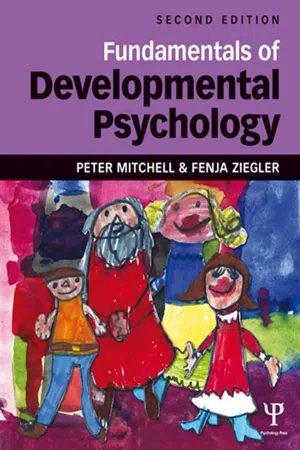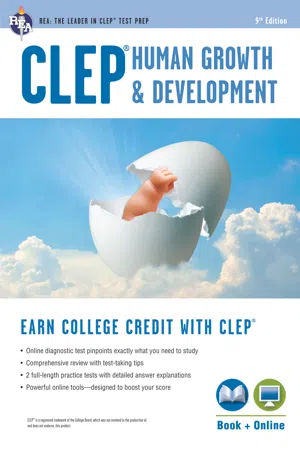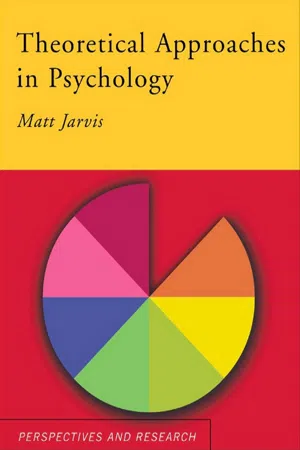Psychology
Cognitive Development in Infants
Cognitive development in infants refers to the growth and progression of mental processes such as perception, attention, memory, and problem-solving abilities. During the first year of life, infants rapidly develop cognitive skills through experiences and interactions with their environment, laying the foundation for future learning and understanding of the world around them.
Written by Perlego with AI-assistance
Related key terms
6 Key excerpts on "Cognitive Development in Infants"
- eBook - ePub
Forensic Psychiatry
Fundamentals and Clinical Practice
- Basant Puri, Ian H. Treasaden(Authors)
- 2017(Publication Date)
- CRC Press(Publisher)
8Developmental psychology
NATHALIA L. GJERSOE AND CATRIONA HAVARD Introduction Cognitive development Personality Social development Sexual development The child as witness Conclusion ReferencesINTRODUCTION
Developmental psychology is a discipline that encapsulates the full spectrum of psychological processes throughout the life span. Theories developed as part of this research have important implications not just for our understanding of children’s behavior and growth but also for how we conceptualize the human mind as a whole. Often there are processes so inextricably interwoven and sophisticated in adults that understanding them requires examination from their inception in the developing brain. This chapter focuses on the age range between infancy and late childhood and summarizes theories of children’s cognitive, personality, social, and sexual development, concluding with an outline of current opinion regarding children’s capacities as eyewitnesses.COGNITIVE DEVELOPMENT
Even newborns come into the world with a toolkit of basic sensory capacities and biases to attend to specific types of information. This stream of information forms the basis for mental representations—patterns of neuronal activity that refer to aspects of the external world. Developmental cognitive psychology examines mechanisms of change in mental representations throughout the life span. Examining Cognitive Development in Infants and young children requires its own set of methodologies distinct from those used to examine adults. Children have limited communication and -comprehension abilities, disorganized or slow motor responses, and are easily distracted. Traditionally, research into cognitive development utilized naturalistic observation of children’s behavior at different ages and manipulated situations to determine if children’s responses changed in a reliable manner from age to age. This work has revealed a host of cognitive capabilities that all typically developing children seem to attain within a very similar time period—referred to as cognitive milestones - eBook - ePub
- Peter Mitchell, Fenja Ziegler(Authors)
- 2013(Publication Date)
- Psychology Press(Publisher)
3 DOI: 10.4324/9780203736357-3Contents
Introduction Stages of cognitive development Piaget’s explanation of cognitive development Traditional learning theory as a contrasting explanation of development A supplement to Piaget’s theory: Self-centered adolescents SummaryThe development of thinking 3
Chapter Aims- To introduce Piaget’s theory of cognitive development. To detail Piaget’s stages.
- To detail the evidence that lends support to Piaget’s stage theory.
- To present the mechanism that Piaget posited as responsible for cognitive development.
Introduction
The discipline concerned with studying the development of thinking is cognitive developmental psychology. The word “cognitive” refers to knowledge, but not necessarily according to the common meaning of the word. When people talk about knowledge, they usually mean the kind of information useful for answering questions in games such as The Weakest Link or Who Wants to be a Millionaire, or in order to do college exams. In contrast, cognitive developmentalists think of knowledge as referring to understanding about things.You might have noticed a child aged around 5 years speaking on the telephone about things only he can see: He seems to overlook the fact that the person he is speaking to is in a completely different location and cannot see the same things. Perhaps this is a sign that the young child is incapable of putting himself in someone else’s shoes. In the broadest sense, it is tempting to suppose that the child does not understand that other people can have different perspectives. Cognitive developmentalists look at particular difficulties children have, such as poor communication ability, and then draw general conclusions about their underdeveloped knowledge of the world. An exciting aspect of cognitive developmental psychology concerns the things children say and do in various situations, and then speculating about the meaning of these in terms of what the child does or does not know about the world. - eBook - ePub
Child Development
Concepts and Theories
- Jean A. Mercer(Author)
- 2018(Publication Date)
- SAGE Publications Ltd(Publisher)
Cognitive changes also display individual differences in developmental change and in the cognitive abilities that are eventually achieved. In industrialized societies, where cognitive abilities are much prized and formal education is provided to facilitate children’s cognitive development, there is concern about whether an individual’s cognitive development is typical or atypical. Children who are atypically rapid in cognitive development are praised and often given extra resources to help their development, whereas children who are atypically slow in cognitive development are given interventions in the form of special education in the hope of helping encourage developmental progress. As was the case for physical growth, normative information about cognitive development is available and allows comparisons between individual children and the larger population of children. Normative information allows the calculation of mental age, a form of developmental age based on comparisons between the individual and children of various chronological ages. Genetic factors play a role in cognitive development, but there has been little discussion of epigenetic factors affecting cognition. The stage concept has been much used in work on cognitive development, but the idea of critical periods has been applied in a very limited way and is confined to the study of language development. Other, less general concepts that have been discussed in earlier chapters are sometimes applied to cognitive development. The idea of plasticity, generally applied to the understanding of brain development, is exemplified by the capacity for learning and the shaping of behaviour by experience - eBook - ePub
Human Growth and Development Across the Lifespan
Applications for Counselors
- David Capuzzi, Mark D. Stauffer(Authors)
- 2016(Publication Date)
- Wiley(Publisher)
Part 2 Birth and InfancyPassage contains an image
Chapter 5 Birth and Infancy: Physical and Cognitive Development
Christie Jenkins, Kerrie R. Fineran, and Amber LangeIntroduction
For the past 6 years, I have watched my twin daughters grow and develop at a rapid pace. It is fascinating to watch both of them achieve milestones at different paces in completely different ways. How can two children split from the same egg be so different? As the information progresses through the chapter, it will become clear how multiple factors impact the physical and cognitive development of children.This chapter begins by exploring physical growth and advancements in motor dexterity. It is important to look at not only the genetic components of growth but also the environmental factors that can help or hinder progress. The intricacies of language development in early childhood will be explored. The next step is to investigate early childhood cognition through the lens of Piaget and Vygotsky. The chapter ends by looking at how information is stored and processed. This will happen through the unique perspective of a counselor.Physical Development
Physical development refers to the organic changes that occur in children as they mature. Some of the imperative characteristics that establish optimal physical development during birth and infancy are changes in physical and brain growth, motor skills, health issues, and learning skills.During the first 2 years of development, children are growing and changing at an exponential rate. Each year, a child can grow 2 to 3 inches in height and put on an additional 5 pounds in weight. Girls tend to be smaller than boys on average. Girls continue to retain body fat as they age while boys tend to be more muscular. As their bodies continue to grow and change, better motor coordination develops.Skeletal Development
The skeletal system is made of cartilage and bone. It is the framework of the body and determines movement while protecting vital organs. The ages from 2 to 6 years bring a large boost in skeletal changes. Growth centers (epiphyses) are hard at work changing cartilage into bone. These are found throughout the skeletal system. Doctors often use these growth centers to predict and diagnose growth disorders in children. - eBook - ePub
- Patricia Heindel(Author)
- 2016(Publication Date)
- Research & Education Association(Publisher)
CHAPTER 6 Cognitive Development Throughout the Life Span Chapter 6 Cognitive Development Throughout the Life SpanELEMENTS OF COGNITIVE DEVELOPMENTThinking is defined as the manipulation of mental representations. Cognition includes the mental activities involved in the acquisition, storage, retrieval, and use of knowledge. The most rapid cognitive development takes place during the first few years of life when the brain is growing rapidly. As the following discussion shows, however, cognitive development is best described as a life-long process.ConceptsA basic element of thought is the concept. A concept is a label that represents a class or group of objects, people, or events that share common characteristics or qualities. We organize our thinking by using concepts, and concepts allow us to think about something new by relating it to a concept we already know.Some concepts are well-defined, and each member of the concept has all of the defining properties; no nonmember does. An example would be registered voters—you either are or are not registered to vote. Other concepts are not so clearly defined but are encountered frequently in our everyday life. These natural concepts have no set of defining features but instead have characteristic features—members of this concept must have at least some of these characteristics. “Bird” is a natural concept. Birds range from chickens to sparrows to ostriches. Prototypes are objects or events that best represent a natural concept. A sparrow or robin would be considered a prototypical bird by many individuals. New concepts are easier to learn if they are organized around a prototype.ReasoningReasoning involves processing information to reach a conclusion. It includes evaluating and generating arguments to reach a conclusion. Inductive reasoning involves reasoning from the specific to the general. For example, drawing conclusions about all members of a category or concept based on only some of the members is inductive reasoning. Deductive reasoning is reasoning from the general to the specific. Making a prediction based on a theory involves deductive reasoning. Logical reasoning involves using mental procedures that yield valid conclusions. - eBook - ePub
- Matt Jarvis(Author)
- 2005(Publication Date)
- Routledge(Publisher)
- Cognitive-developmental theory has been applied successfully in the field of education. Modern teaching techniques ranging from individual discovery learning to computer-aided work in pairs has been influenced by the work of Piaget and Vygotsky.
- There are other situations in which it is helpful to have a good understanding of the way in which children think. These range from play-work, in which it is helpful to understand children’s concepts of rules, to anaesthesiology (the study of pain and pain relief), where it is invaluable to have a grasp of children’s understanding of the pain they are experiencing as a result of medical conditions and medical procedures.
Despite these invaluable contributions, a cognitive-developmental approach is not generally considered to be sufficient for a complete understanding of psychology, or even of child psychology. Some of its limitations include the following:- From a psychodynamic perspective, the cognitivedevelopmental approach neglects the importance of children’s emotional development. In a sense this is not a fair criticism of Piaget, who admired the work of Freud (see Chapter 3 ) and saw his own work as complementing rather than rivalling Freud’s theories. However, it is fair to say that the cognitivedevelopmental approach does not really tackle emotional development, which is clearly of huge importance to children’s psychological development.
- From a behavioural perspective (see Chapter 2 ), the cognitivedevelopmental approach overemphasises speculation about mental processes at the expense of more scientific research into the importance of conditioning in learning.
Summary
Cognitive-developmental psychology is an approach to understanding the development of logical thought, and the ways in which this impacts on our behaviour. The most influential theory in this area comes from Piaget, whose major contribution was in identifying the ways in which childhood logic differs from that of adults. Piaget also emphasised the process by which children explore and learn from their environment. Vygotsky broadly agreed with many of Piaget’s ideas, but placed more emphasis on the importance of learning from others than learning by discovery. Both Piaget’s and Vygotsky’s ideas have been applied to teaching. The ideas of both Piaget and Vygotsky point towards an active role for pupils in their learning, but whereas followers of Piaget advocate solo discovery learning, educationalists influenced more by Vygotsky tend to prefer group work and more help by teachers and other learners. Computer-aided learning, a growth area in education, can be understood from the viewpoints of both Piaget and Vygotsky.
Learn about this page
Index pages curate the most relevant extracts from our library of academic textbooks. They’ve been created using an in-house natural language model (NLM), each adding context and meaning to key research topics.





